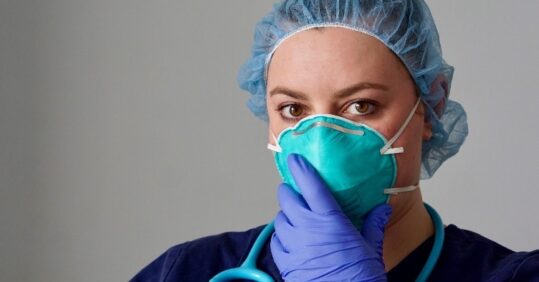PHE advice on how to put on and take off personal protective equipment

When to use a surgical face mask or FFP3 respirator
When caring for patients with suspected or confirmed Covid-19, all healthcare workers need to – prior to any patient interaction – assess the infectious risk posed to themselves and wear the appropriate PPE to minimise that risk.
When to use a surgical face mask
1. Close patient contact (within one metre)
For example: Providing patient care, direct home care visit, diagnostic imaging, phlebotomy services, physiotherapy, etc
PPE to be worn • Surgical face mask • Apron • Gloves • Eye protection (if risk of contamination of eyes by splashes or droplets)
2. In cohorted area (but no patient contact)
For example: Cleaning the room, equipment cleaning, discharge patient room cleaning, etc
Related Article: Improving lung health one song at a time
PPE to be worn: • Surgical face mask (along with other designated PPE for cleaning)
When to use an FFP3 respirator
1. When carrying out aerosol generating procedures (AGP) on a patient with possible or confirmed Covid-19
2. In high-risk areas where AGPs are being conducted (eg: ICU)
The AGP list is: • Intubation, extubation and related procedures such as manual ventilation and open suctioning • Tracheotomy/tracheostomy procedures (insertion/open suctioning/removal) • Bronchoscopy • Surgery and post-mortem procedures involving highspeed devices • Some dental procedures (such as high-speed drilling) • Non-Invasive Ventilation (NIV) such as Bi-level Positive Airway Pressure (BiPAP) and Continuous Positive Airway Pressure ventilation (CPAP) • High-Frequency Oscillating Ventilation (HFOV) • High Flow Nasal Oxygen (HFNO), also called High Flow Nasal Cannula • Induction of sputum
PPE to be worn • FFP3 respirator • Long sleeved disposable gown • Gloves • Disposable eye protection. Always fit check the respirator
Source: Public Health England, When to use a surgical face mask or FFP3 respirator and Public Health England, Covid-19: infection prevention and control [updated 21 March]
Putting on PPE for non-aerosol generating procedures (AGPs)
Before you put on PPE:
- ensure healthcare worker is hydrated
- tie hair back
- remove jewellery
- check PPE in the correct size is available.
1. Perform hand hygeine.
2. Put on apron and tie at waist.
3. Put on facemask – position upper straps on the crown of your head, lower strap at nape of neck.
4. With both hands, mould the metal strap over the bridge of your nose.
Related Article: Nurse had to ‘freeze’ PPE during pandemic to re-use in care home, Covid inquiry hears
5. Don eye protection if required.
6. Put on gloves.
Source: Public Health England, Putting on personal protective equipment (PPE) for non-aerosol generating procedures (AGPs) and Public Health England, Covid-19: infection prevention and control [updated 21 March]
Taking off PPE for non-aerosol generating procedures (AGPs)
- PPE should be removed in an order that minimises the risk of self-contamination
- Gloves, aprons (and eye protection if used) should be taken off in the patient’s room or cohort area
1. Remove gloves.
- Grasp the outside of glove with the opposite gloved hand; peel off.
- Hold the removed glove in the remaining gloved hand.
- Slide the fingers of the un-gloved hand under the remaining glove at the wrist.
- Peel the remaining glove off over the first glove and discard.
2. Clean hands.
3. Remove apron.
- Unfasten or break apron ties at the neck and let the apron fold down on itself.
- Break ties at waist and fold apron in on itself – do not touch the outside – this will be contaminated. Discard.
4. Remove eye protection if worn.
- Use both hands to handle the straps by pulling away from face and discard.
5. Clean hands.
Related Article: Call for regulatory guidelines as NHS adopts AI in dermatology care
6. Remove facemask once your clinical work is completed.
- Untie or break bottom ties, followed by top ties or elastic, and remove by handling the ties only.
- Lean forward slightly. Discard.
- DO NOT reuse once removed.
7. Clean hands with soap and water.
Source: Public Health England, Taking off personal protective equipment (PPE) for non-aerosol generating procedures (AGPS) and Public Health England, Covid-19: infection prevention and control [updated 21 March]
This advice was first published on Nursing in Practice’s sister title Pulse.

See how our symptom tool can help you make better sense of patient presentations
Click here to search a symptom


When caring for patients with suspected or confirmed Covid-19, all healthcare workers need to ? prior to any patient interaction ? assess the infectious risk posed to themselves and wear the appropriate PPE to minimise that risk.



